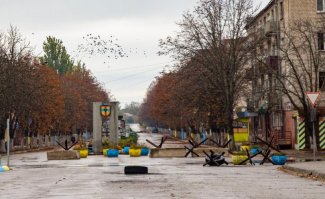43% of Ukraine’s defence budget. 253rd day of the war

Prime Minister Denys Shmyhal announced the adoption of Ukraine’s 2023 budget. It provides for 43% of the total expenditure, or more than 1.1 trillion hryvnias (more than $30 billion), for security and defence. Social payments and benefits – the second largest item – will account for 17%. The state’s revenues are estimated at 1.3 trillion hryvnias, accounting for 51% of all planned receipts, while international support is to finance 46% of budget expenditure. Finance Minister Sergiy Marchenko said that the budget had been prepared on the assumption that the war would continue throughout next year.
The centre of gravity of the fighting in Donbas has shifted to the area between Donetsk and the Zaporizhzhia Oblast border. The situation is heaviest in the Vuhledar area, which Russian forces are trying to outflank. Aggressor pressure on Ukrainian positions in an arc west of Donetsk has increased. As a result, the defenders decided to evacuate the population of Marinka completely. Further Russian attacks on Bakhmut, Soledar, north of Horlivka and east of Siversk were to fail. The invaders were to move to counterattack between Svatove and Kreminna in the Luhansk Oblast and attack the defenders’ positions along the Zherebets River line. Ukrainian forces renewed their assault attempts on the border of Kharkiv and Luhansk oblasts east of Kupiansk and northeast of Svatove. In the Kherson Oblasts, Ukrainian units continued attempts to break Russian positions, attacking south of the Davydiv Brid–Dudchany line. According to unofficial information, they were about to seize the village of Mala Seidemynukha on the Inhulets River.
The Russians still carry out attacks on energy and industrial infrastructure using missiles and drones, but their intensity has reduced. There have been hits on facilities in Kharkiv, Kryvyi Rih, Mykolaiv (targets included a port), Pavlohrad and Pokrovsk in the Donetsk Oblast, as well as in the Zaporizhzhia area. Both sides shelled and bombarded enemy positions and facilities along the contact line. Ukrainian forces were to carry out further acts of diversion in and around Melitopol (including in the area of the railway bridge in Svitlodolynske).
Commander-in-Chief of the Armed Forces of Ukraine General Valerii Zaluzhnyi noted that the number of Russian attacks had tripled to 80 per day ‘on selected sections of the frontline’. In turn, Deputy Chief of the General Staff’s Main Operational Directorate, General Oleksiy Hromov, reported that on the right bank of the Dnieper (in Kherson and Mykolaiv oblasts), the number of attacks carried out by Russian aviation on Ukrainian positions had increased significantly. This is said to be due to the difficulties of logistical security for the artillery subunits operating there. Hromov also stated that Russian soldiers conscripted into units in the course of ‘partial mobilisation’ are arriving in Belarus and that the formation of a strike grouping may not occur until two to three months. According to him, Russia wants to force Ukrainian troops to pull forces from the east and south of the country in this way. The Russian command attaches great importance to using the air base in Luninets (Brest Oblast), where a unit equipped with Iranian combat drones is stationed.
According to General Mykhailo Zabrodskyi, deputy chairman of the parliamentary defence commission and former commander of the landing and assault troops, the Russians will leave Kherson without a fight. However, in the spring of 2023, they may carry out two offensive operations – in the south from the Zaporizhzhia region towards Dnipro and the northeast towards Sumy, Poltava and Dnipro. In turn, the task of the invading forces deployed in Donetsk and Luhansk oblasts will be to contain and tie down parts of the Ukrainian army. Zabrodskyi also did not rule out a threat from Belarus. The strategic goal of such an operation would be to encircle the Ukrainians on the left bank of the Dnieper and force Kyiv to start peace negotiations. According to him, Ukraine must create three new operational groupings – in Zaporizhzhia, the Sumy Oblast and Volhynia.
On 2 November, the Belarusian Interior Ministry announced that it plans to create ‘combat teams’ made up of special forces reservists to carry out combat missions in the event of ‘mercenary’ incursions into Belarus. Recruitment to the ‘teams’ will be conducted by the Belarusian Association of Veterans of Special Forces Units of the Interior Ministry called ‘Honor’. Earlier, KGB chief Ivan Tertel indicated, among other things, that the West’s plans included ‘the armed seizure of a regional centre on Belarusian territory as a springboard for the further development of an offensive operation’.
On 3 November, the occupation authorities in Kherson reported a high probability of Russian forces leaving the city. Residents were advised to get to the other bank of the Dnieper as soon as possible. According to the Ukrainian authorities, the occupying forces are looting the city (among other things, all ambulances and fire engines have been taken away).
The Bulgarian National Assembly agreed to increase repairs to Ukrainian military equipment and the transfer of light armaments. The government was obliged to prepare a supply plan for Kyiv within 30 days.
The Slovakian ‘Denník N’ reported on 4 November that dual-use goods used by Russia in its invasion of Ukraine were coming through Slovakia (directly or indirectly). The Ukrainian army was said to have detected Austrian Rotax 912 engines for civilian aircraft in a downed Iranian drone. The manufacturer itself denied that it had made a similar transaction. However, it is known that the Slovak customs office approved exporting these engines to Iran to the national company at the end of April. ‘Denník N’ presented an extensive list of dual-use goods (including engines, bearings, and wheel parts) that were going through Slovakia to Russia and could be used in producing weapons, including heavy weapons. The Ministry of Defence has already taken steps to establish the details and curb the practice.
The Swiss government refused to grant permission to re-export from Germany to Ukraine of 35 mm ammunition for the previously supplied Gepard self-propelled anti-aircraft guns. Germany was requesting 12,400 cartridges, a symbolic amount (20 units of fire) in the context of the 30 double-barrel Gepards handed over to the Ukrainian army (some sources report 24 in use). Germany has donated 60,000 rounds of ammunition along with the Gepards, but this stock has already been exhausted.
Commentary
- The planned budget expenditure for 2023 confirms earlier announcements by the Ukrainian authorities that they are preparing for a prolonged war. It is also another – after the supply of armaments, military equipment and war materiel – indicating that Kyiv fully depends on Western financial assistance for its military operations. It should be stressed that Ukraine’s budget most likely does not include in any form the unpaid military support provided by the allies (apart from equipment and war materials), including in the form of organised training and monetary donations to finance it. However, if one takes into account the information provided a few days earlier by Sergiy Kyslytsya, Ukraine’s ambassador to the UN, according to which the disclosed value of military support to Ukraine during the ten months of this year amounted to €41.3 billion, the cost of warfare may turn out to be greater than the entire revenue portion of next year’s budget.
- General Zabrodskyi’s presentation of the direction of potential Russian operations should be seen primarily as intended to justify the need to expand Ukraine’s operational troops and as a signal to the West to equip the new units fully. Due to the insufficient amount of equipment, especially heavy weapons, Ukraine could not create new units. The mobilisation conducted after 24 February was mainly for replenishing personnel and forming territorial defence subunits. Deliveries of armaments and military equipment from the West, and partly also war acquisitions, remain insufficient to replenish existing units. However, the formation of new tactical unions will become a prerequisite if the aggressor’s grouping (currently around 250,000 troops) is to be further increased.
- Alarmist communiqués from the occupation authorities in Kherson, who call on the population to leave the city, testify to the difficult situation of the Russian forces in the region. Despite this, there have been no signs of the aggressor’s troops withdrawing, and defensive lines are being extended. On the other hand, the evacuation of the population is likely to facilitate the turning of the towns around Kherson into fortified defensive points. As President Volodymyr Zelensky admitted earlier, it cannot be ruled out that spreading news of the possibility of Russian troops withdrawing from the city is a disinformation operation. It aims to encourage Ukrainian forces to go on the offensive and, consequently, lead to heavy casualties due to an assault on well-prepared Russian defence lines. The cautiousness of Ukrainian forces in the south may also be because their possible attack on Kherson would require an increase in the number of units being moved from other front sections. This could make it easier for the Russians to launch an offensive in eastern Ukraine.





